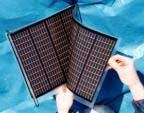In results presented at the IEEE Photovoltaic Specialists Conference, HelioVolt Corporation announces that its proprietary FASST® reactive transfer printing process has produced thin film solar cells with 12.2 percent conversion efficiencies in a record setting six minutes. The efficiencies place HelioVolt’s Copper Indium Gallium Selenide (CIGS) devices among the highest performing solar thin film products on the market today. HelioVolt is currently optimizing FASST for further efficiency gains and scaling up the process to begin commercial manufacture of thin film solar modules and building integrated solar products.
“In the lab, CIGS is already achieving the highest efficiencies of any thin film solar material. The challenge of course is transferring that efficiency to a high throughput, high yield, low cost process capable of delivering gigawatts worth of quality commercial product,” said Dr. BJ Stanbery, CEO and founder of HelioVolt. “We view these high-performance results as an indicator of FASST’s potential to meet that need. We’re already producing CIGS devices that are comparable with the highest efficiency thin film products on the market today, and we still see plenty of room to improve from here.”
Thin film technologies aim to lower the cost of photovoltaic (PV) products by reducing the amount of material required to produce electricity from the sun. HelioVolt’s FASST process further reduces costs by manufacturing CIGS thin film products ten to one hundred times more rapidly than competitive processes including co-evaporation and two-stage selenization. Confirmed by independent testing at Colorado State University, the high-throughput printing process delivers a uniform photovoltaic cell with high conversion efficiency, or percentage of sun energy the device converts into electricity. HelioVolt’s 12.2 percent efficiency devices consisted of CIGS photovoltaic thin film layer applied to a glass substrate. The FASST process can also be used to print high efficiency, low-cost thin film material directly on glass substrates for solar modules or onto building products including architectural glass and roofing tiles.

